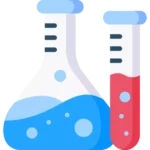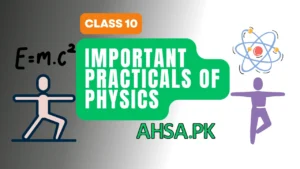Guess Paper Chemistry for Class 9 is up-to-date and the most important questions are given according to Punjab boards. These guess papers will help you get the highest marks in your papers. The Punjab Board guess paper Chemistry is relevant to all chapters, and we have tried to include all necessary questions that help students score more than seventy percent.
9th class Chemistry guess paper by Ahsa.Pk is available and you may ask if you need any assistance from our qualified team. Chemistry Class 9 guess papers are for helping material that may enhance the student’s chances of getting more marks in less time.
Guess Paper Chemistry Class 9
9th Class Chemistry Important Short Questions
Chapter 1
- Define physical properties with two examples.
- Define the atomic mass unit; why is it needed?
- Define compound and give an example.
- Define empirical formula with an example.
- Define element.
- Define mixture with an example.
- Define relative atomic mass with its unit.
- Differentiate between molecular mass and formula mass.
- How does homogenous mixture differ from hetrogenous mixture?
- What is the difference between atomic no. and atomic mass?
- Define Avogadro’s Number.
- Which one has more molecules: 9g of water or 9g of sugar.
- Differentiate between homoatomic and hetroatomic molecules.
Chapter 2
- How are canal rays produced in discharge tube?
- Differentiate between shell and subshell with example.
- Give defects of Rutherford’s atomic model.
- Define electronic configuration with an example.
- An element has atomic number. 17. How many electron are present in K, L, and M shell of the atom.
- Write any two postulates of Bohr’s atomic model.
- What is meant by quantum or quanta?
- Write down electronic configuration of Al3+. How many electrons are present in valence shell.
- Give two observations of Rutherford’s atomic model.
- Write electronic configuration of P, Cl1-, Na1+, Mg2+.
Chapter 3
- Why shielding effect of electrons makes cation formation easy?
- Why and how element are arranged in 4th period?
- What is Doberiener’s Tiads?
- Define atomic radius.
- Give trend of ionization energy in group and period.
- What is periodic function?
- Define electron affinity.
- Why are nobel gases non reactive?
- Why the elements are called s and p block elements?
- What do you mean by periodic function?
- Write the names of the elements of group-I with symbols.
- Why is the trend in period is same for electron affinity and electonegativity?
- Differentiate Modern and Mendeleev’s periodic table.
- Define group and period in periodic table.
- What are transition metals?
- Give the reason for the increase electron affinity in period.
- Define electronegativity.
Chapter 4
- What type of covalent bond is formed in N molecule?
- Differentiate between polar and non-polar covalent bond.
- What is coordinate covalent bond?
- Differentiate between lone pair and bond pair of electron.
- Define ionic and covalent bond.
- How does a polar bond becomes polar?
- Define hydrogen bonding with an example.
- Why HCl has dipole-dipole forces of attraction?
- Covalent bond in H2 is non-polar. Why?
- What is dative covalent bond?
- How does covalent bond becomes polar?
- Types of covalent bond are all important. Why?
- What is the relation between electronegativity and polarity?
- Metals are good conductors of electricity. Why?
- What is the difference between inter-molecular and intra-molecular forces?
- Why ice floats on water?
- Why is the bond between electropositive and electronegative atoms is ionic?
Chapter 5
- What do you mean by evaporation and how it is affected by surface area?
- What is the effect of temperature on evaporation?
- What is the effect of external pressure on boiling point?
- Define Boyle’s law and Charles’ law.
- Define vapour pressure.
- Why does H2 diffuse rapidly than O2?
- Differentiate between evaporation and boiling point.
- Define absolute zero.
- Define melting point and freezing point.
- Define condensation.
- Define pressure and give its SI unit.
Chapter 6
- Differentiate between solution and mixture.
- Differentiate between solvent and solute.
- Define molarity. Give its unit and formula.
- Define the molar solution.
- Define a solution with an example.
- Define aqueous, dilute, concentrated, saturated, and unsaturated solutions.
- Define solubility.
- What is the Tyndall effect?
- Explain like dissolves like.
- How molar concentration of NaOH is prepared?
- What is mass/mass %?
- What is mass/volume %?
- What is volume/volume %?
- Why solutions are not showing a Tyndall effect?
Chapter 7
- Define oxidation and reduction in terms of ions.
- Define redox reaction with an example.
- Differentiate between valency and oxidation number.
- Find the oxidation number of HNO3.
- Define oxidizing and reducing agents.
- Define strong, weak, and non-electrolytes.
- Define electrolysis.
- Define spontaneous and non-spontaneous reactions.
- What is an electrochemical cell? Give its types.
- Define corrosion and give its preventions.
- How is galvanizing done?
- Why is O2 necessary for rusting?
- Define electroplating.
- Define alloy.
- What happens to iron in the rusting process?
Chapter 8
- Why does the reactivity of metals increase down the group?
- What do you mean by the electropositive character?
- Give the physical properties of metals.
- Why the 2nd ionization energy of Mg is greater than the 1st one?
- Why is calcium more electropositive than magnesium?
- Why is Cu used for making electrical wires?
- Name the moderately reactive metals.
- Give four uses of platinum.
- What are the applications of silver?
- Give uses of gold.
- Name any four reactive metals.
- Give the physical properties of non-metals.
- Why is HF a weaker acid than HCl?
- Differentiate between alkali and alkaline earth metals.
9th Class Chemistry Important Long Questions
Chapter 1
- State five differences between compound and mixture.
- Define molecule. Explain its types.
- Explain physical properties in detail.
- Give four branches of chemistry.
- How to write a chemical formula?
Exercise Numericals
1, 3, 4, 6, 7, 9
Chapter 1 Examples
1.2, 1.3, 1.4, 1.5
Chapter 2
- Give five properties of cathode rays.
- Differentiate between Rutherford and Bohr’s Atomic Models.
- How the neutron was discovered. Give properties.
- Give uses of isotopes.
Chapter 3
- Explain the salient features of the Modern Periodic Table.
- Defthe atomic radius. Give its trend in periods and groups.
- Define the shielding effect. Give its trend in periods and groups.
- Define the atomic radius. Give its trend in periods and groups.
- Define electron affinity. Give its trend in periods and groups.
Chapter 4
- Write properties of metals.
- Explain ionic bond with example.
- Explain hydrogen bonding with structure, examples, and effects.
- Explain covalent bonds in detail.
- Explain coordinate covalent bonds.
- Write properties of covalent compounds.
Chapter 5
- Explain Boyle’s law. Prove it experimentally.
- Explain Charles’ law. Prove it experimentally.
- Define boiling point. Explain the factors affecting boiling point.
- Define vapour pressure. Explain the factors affecting vapour pressure.
- Define evaporation. Explain the factors affecting evaporation.
Chapter 6
- Compare suspension and colloid.
- Give characteristics of solutions.
- How dilute solutions are prepared from concentrated solutions?
- Explain saturated solutions.
Chapter 7
- Define oxidation number. Write the rules for oxidation numbers.
- Explain the redox reaction with suitable examples.
- What is electrolytic cell? Explain its working.
- Explain Down’s Cell with the help of diagrams and chemical equations.
- Discuss the working of Daniel’s cell.
- Explain the rusting of iron.
- What is electroplating? Explain the electroplating of silver.
- What is electroplating? Explain the electroplating of chromium.
- Give methods to prevent corrosion.
Chapter 8
- Discuss the electropositive character of metals.
- Write chemical properties of metals.
- Write chemical properties of non-metals.
Guess Papers for Class 9
Schemes of Class 9
Click here for the 9th Class MCQs Test











